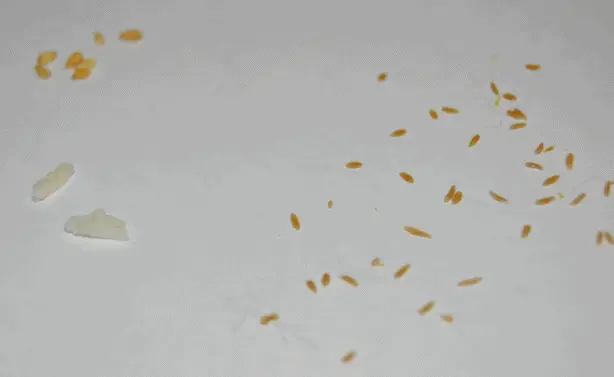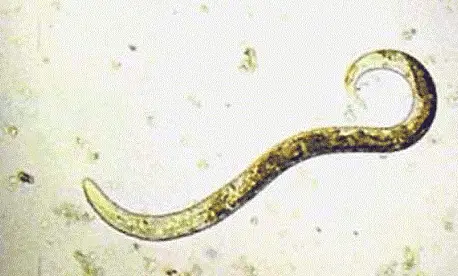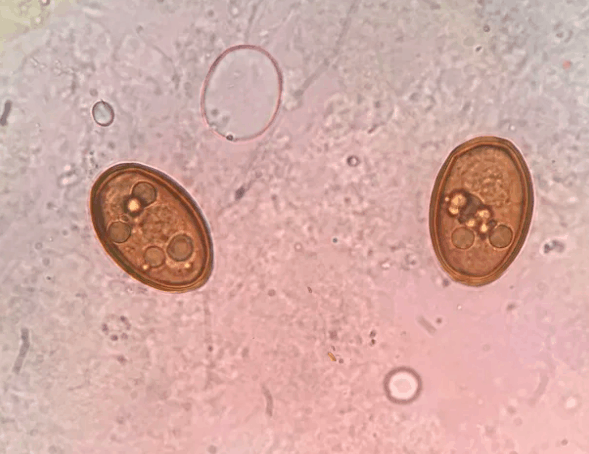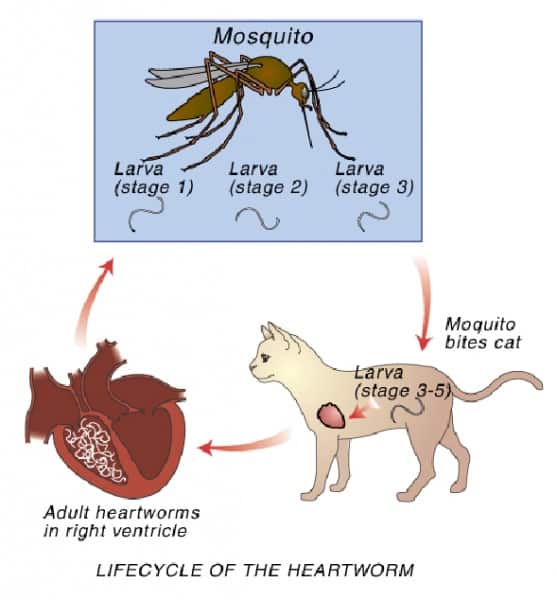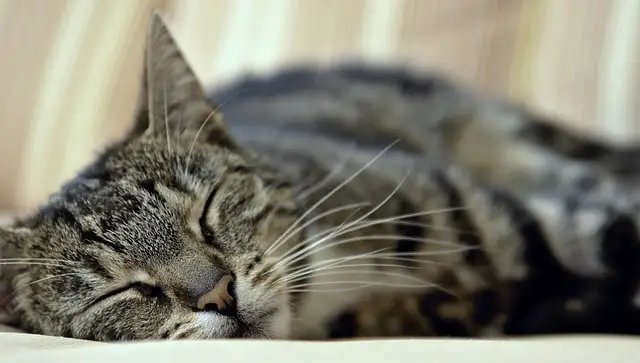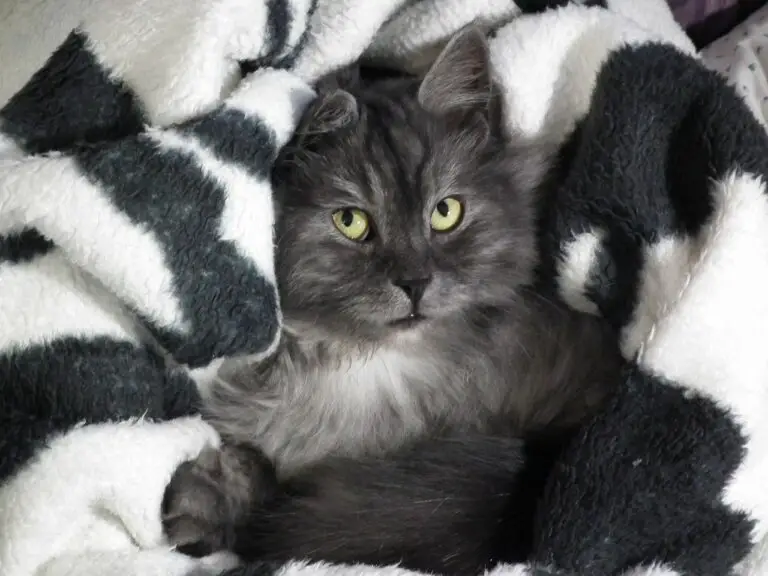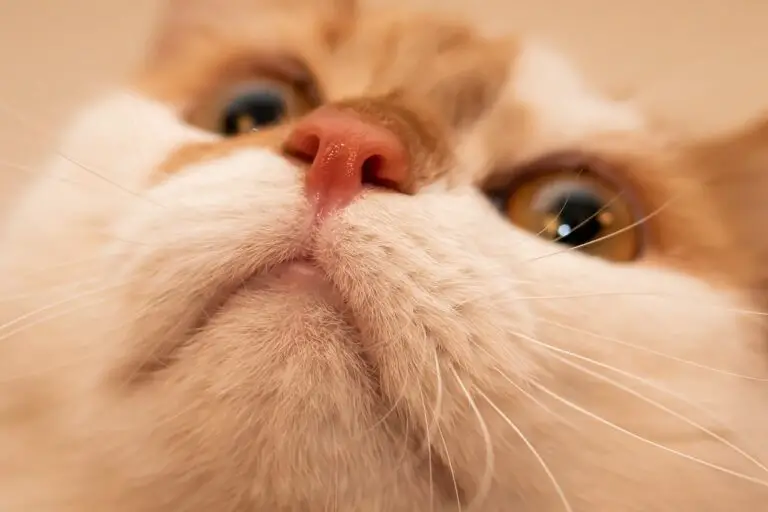CAN I GET WORMS FROM MY CAT SLEEPING IN MY BED?
Can I get worms from my cat sleeping in my bed? If you are sleeping with your cat, this question can surface. It is a fantastic experience to cuddle with our cats, but is it safe? What can we do to make it safe?
Most worms can transmit to humans through ingesting cats feces containing worms or eggs from worms. Water and food that came in contact with cats’ feces and thus contaminated can pass worms to humans. A good rule of thumb is to wash hands often and often clean to prevent getting worms.
Let’s see all the specifics.

WHAT ARE WORMS?
Before getting into answering the question of cats transmitting worms to humans if they sleep with them, we should get a bit of basics knowledge about worms and how they get into our cats. It will be easier to answer this question in full later on.
Worms are many different distantly related animals with a long cylindrical tube-like body, no limbs, and no eyes. Worms vary in size from microscopic to over 1 meter (3.3 ft) in length. Various types of worms occupy a small variety of parasitic niches, living inside other animals’ bodies. (Ref. Wikipedia)

Cats can get several types of worms, called in different ways due to how they look like. Those worms live inside their bodies and survive through what is ingested from cats and using their host bodies as a resource for things they need. In trying to survive, they can make their host sick.
WHAT TYPES OF WORMS CATS CAN GET?
There are several types of worms cats can get; each one has a different shape and form. Each type of worm could be transmitted differently, even though most worms have similarities in how they operate. I have also to mention that they are gross, and poor cats need to be helped get rid of them and even prevent getting them.
Here the most common worms in cats and how they look like:
- TAPEWORMS
Tapeworms are a flat type of worms that live in the intestine of a cat. They are flat but also segmented, and they look like tape. From there, the name “tapeworms.” Cats can release tapeworms in segments. They look like rice or sesame seeds. You could find pieces around the house, in your cat feces, in his bed, near your cat anus, and the most common places used by your cat. They can be from 4-24” in length.
Cats typically get in tapeworms through fleas or by eating other animals infected by tapeworms.
- ROUNDWORMS
The most common intestinal parasites in cats, roundworms measure about 3-4” long and resemble spaghetti, cats come in contact with them by infected feces from other animals. The can start to live in the intestine, but those types of worms can travel to other parts of the cat body, like the liver, lungs and more.
- HOOKWORMS
Hookworms are usually less than 1” long and live in cats’ small intestines. These worms are named for the hook-like teeth. These parasites feed on blood, causing diarrhea and anemia. Hookworm eggs are expelled through feces, and this is how they find new hosts.
- WHIPWORMS

Those worms are called whipworms because they look like a whip, with a thick anterior part and more thin posterior part. They reside in the intestine, and from there, they lay eggs that get out of your cat’s body through feces, so they can infect other animals and continue surviving.
- LUNGWORMS
Those types of worms pass in cats when they eat animals that were previously contaminated. They attack the respiratory tract in cats creating respiratory problems. Usually, they do not pass on with feces, even though in some cases it can happen.
- BLADDER WORMS
The parasite can irritate the mucosa of the urinary system (bladder and tract), sometimes with painful urination and incontinence. They reportedly infect the large intestine but have been found in the cat’s urinary bladder, resulting in feline lower urinary tract disease (FLUTD). In cats with a heavy infection, symptoms can include frequent urination, painful urination, bloody urine, straining to urinate. (Ref. Wikipedia)
- LIVER FLUKE
The cat liver fluke is a parasitic worm that infects the liver and pancreas of cats. Outdoor cats who hunt are most at risk of liver fluke infection. Flukes spread when infected cats pass their eggs in feces. If your cat eats an infected lizard, he becomes infected with the parasite.
- HEARTWORMS
Heartworms are a blood-borne parasite that resides in the heart or adjacent large blood vessels of infected animals. The female worm is 6 to 14 inches long (15 to 36 cm) and 1/8 inch wide (5 mm). The male is about half the size of the female.
Heartworms require the mosquito as an intermediate host, and as many as 30 species of mosquitoes can act as this host and transmit heartworms.
When an infected mosquito bites a cat, it injects infective larvae into the cat. The larvae migrate and mature for several months, ending up in the right side of the heart and the pulmonary arteries.
Because of this life cycle, a cat must be bitten by an infected mosquito to become infected with heartworms. Heartworms are not transmitted directly from one cat to another or from a dog directly to a cat.
(ref. https://epethealth.com/)
CAN HUMANS GET WORMS FROM THEIR CAT?
There are ways for humans to get worms from cats. Typically, worms would get expelled through cat feces or produce eggs that will also get out with feces. Commonly, contaminated feces or soil should be ingested by a person to get worms from a cat.
Fleas are another way to transmit worms to humans, but again, one must ingest a contaminated flea. A garden or grass can contain feces from dogs or other animals that have worms. Therefore, one must be alerted to what is being touched and not put hands near the mouth if there are accidents.
Common methods of transmission include:
- Children playing in sandboxes where cats have defecated
- Walking barefoot through contaminated soil
- Gardening in soil without wearing gloves
As a general rule, it is essential to avoid contact with animals’ feces and get rid of fleas. Today, cats are treated for worms by vets, and there are deworming treatments a cat owner can do easily at home, even as prevention. Therefore, it is not so common for a cat owner to get worms from a cat. Many preventive measures are taken by vets, especially if your cat goes for a check-up routinely.
But, it can still happen. Therefore cat owners need to know what they can do to prevent their cats and themselves from becoming victims of worms.
But, Can I get worms from my cat sleeping in my bed?
CAN I GET WORMS FROM MY CAT SLEEPING IN MY BED?
After the above basics information, we can now answer the question: can I get worms from my cat sleeping in my bed?
Your cat sleeping in your bed is not sufficient to transmit worms. You have to ingest contaminated faces and fleas. It is possible to touch cats’ butts that are contaminated and accidentally put the hand in the mouth. Cats have those weird habits to put butts in people’s faces. They are cats, and this is what they do.
If the vet regularly checks your cat, and if you know that he is healthy, risks are less, of course. Besides bringing cats to the vet regularly and having them dewormed, one can also do the following:
- Wash hands and sanitize them often
- Keep the litter box as clean as possible.
- Clean the house regularly and keep the environment clean
- If your cat has diarrhea or litter box accidents, disinfect and clean the place where the poop has been. Do not touch the poop.
- If your cat has diarrhea, you could wipe your cat butt with disinfectant napkins.
- Wash your bedding often.
Washing hands often is one of the best prevention methods. Following some simple rules to prevent cats from getting worms, deworming them, and keeping clean can allow a cat owner to enjoy cuddling time with their cats.
HOW DO CATS GET WORMS?
Cats get worms in the same way we would get it from them. They have to contact contaminated feces from other animals, maybe some residue on their paws, which they lick when they groom themselves.
Or cats have eaten animals that are infected with worms, or fleas are bringing worms to them.
Indoor cats may be a bit safer from outdoor cats, but they can still get worms. Fleas can come into the house through visits, or they can chase animals that can transmit worms. Outdoor cats are hunting rodents and other prey. For them, the risk to ingest contaminated materials is way higher.
There is no way to control everything that cats do. Whether they are indoor or outdoor, cats can get themselves into anything. The best way to help them stay away from worms is through prevention methods and routine checks and remedies.
HOW TO PREVENT CATS FROM GETTING WORMS?
It is not always possible what cats put through their mouth, but it is possible to do many other things to prevent cats from getting worms:
- Fleas treatments, keep your cat free of fleas.
- Vacuum clean often, especially your cat sleeping place and lounge place.
- Disinfect as much as possible around the house
- Keep your cat out of your garbage and dirty places.
- Keep his litter clean.
- Bring your cat to the vet for the year-round use of heartworm, intestinal worm, and parasite prevention.
- For outdoor cats, if you know where your cat poop, clean it away.
- A lot of cleaning and hygiene.
- Use mosquito nets to prevent mosquitos from coming into the house and bite your cat to prevent worms transmission.
Bringing your cat to the vet for the deworming treatment every year can give a good piece of mind to cats owner who wants to sleep and cuddle with their cats. Veterinarians can provide even more advice and possibly another type of treatments you can do at home every other month.
SYMPTOM OF WORMS IN CATS
Depending on which type of worm a cat may have, there are several symptoms manifesting. Some are similar. Some others are different. Here signs you can expect a cat to have if there are worms problems:
- Soft stools
- Constipation
- Intestinal discomfort
- Swollen abdomen
- Anorexia
- Poor coat quality
- Anal irritation
- Excessive licking of the anal area
- Vomiting (sometimes with worms in the vomit)
- Diarrhea (with or without blood)
- Tarry feces
- Weight loss
- Distended abdomen
- Skin lesions
- Constant coughing
- Difficulty breathing
HOW TO GET RID OF WORMS IN CATS?
Treatments for worms in cats exist and can be administered by a veterinarian. In fact, dewormer exist, can be injected in cats or given orally.
To ensure we are taking care of our cat in the best way possible, it is always better to visit the vet. Treatments delivered by vets are most effective.
The medications used can be Panacur (fenbendazole) and Drontal Plus (pyrantel, praziquantel, fenbendazole) to treat hookworm and roundworm, whipworm, and tapeworm infections. The vet will tell you how many doses and monitor your cat to see if the cure has reached a result.
MY CAT HAS WORMS: HOW DO I CLEAN MY HOUSE?
If your cat has worms, it is necessary to deworm your cat first so that it will stay worms free when you clean the house. Otherwise, your cat will continue to get rid of worms and worms eggs.
Here are things that you can do to clean your house and get rid of worms:
- Wash and clean the litter box with bleach, ammonia, and boiling water (or hot, very hot water). You can spray bleach on the litter box and leave it immersed in bleach for a while.
- Use bleach, ammonia, and other disinfectants to clean the rest of your house: floor, surfaces, etc.
- Wash all beddings, cat beds in the washing machine, using high temperatures in combination with the washing machine soap.
- Vacuum clean everywhere and often to remove eggs worms.
- If you have mosquitos in the house, move your cat away to another room and use a product that kills mosquitos. Do this in every room, while your cat is always kept away.
- Better get mosquito nets and have them on every window and door for future prevention.
Remember to wash your hands often and wear gloves if possible.
RELATED QUESTIONS
Here some related questions and related answers:
- Can I get tapeworms from sleeping with my cat?
It is possible but really rare. You have to ingest contaminated feces. For this to happen you have to touch your cat butt, and then your mouth. Precaution are never enough, therefore keep your cat dewormed, keep your house clean, keep mosquitos and fleas away. There is no reason to not enjoy cuddling time with your cat if you follow the rules.
- How likely is it to get worms from your cat?
It is unlike for an adult to get tapeworms or other worms from a cat. Adults do not have the habit of putting everything they touch in their mouths. Kids are more likely to get worms when playing with pets or outside, where they can come in contact with contaminated soils or feces.
- Is it OK if my cat sleeps in my bed?
Yes, if your cat is vaccinated and healthy, there is no reason for not sleeping with your cat. Cuddling and sleeping with cats is one of the best moments of a cat owner.
- Can you get worms from kissing your cat?
Only if your cat has just come in contact with his own feces and you ingest them after kissing your cat.
CONCLUSION
I hope this was useful and you know how to enjoy cuddling your cat. If you have questions or want to add anything, leave it in the comments below.



